Digital Poster
Osteoarthritis
ISMRM & ISMRT Annual Meeting & Exhibition • 10-15 May 2025 • Honolulu, Hawai'i

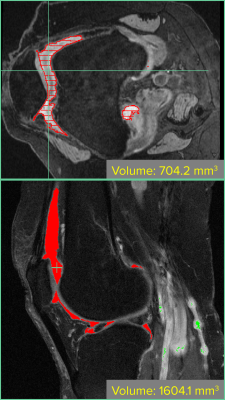 |
Computer Number: 97
4681. Reliability
and Validity of Novel Multi-View, Whole-Knee Effusion-Synovitis
Quantification with Axial and Sagittal Segmentation on 3T Knee
MRI
G. Gilles, D. Robles, L. Grawer, N. Christiansen, R. R.
Tang, M. Taljanovic, J. Duryea, E. Bedrick, C. Kwoh
University of Arizona College of Medicine, Tucson, United States
Impact: Our results have broad public health impact,
given the prevalence of knee osteoarthritis. Our next step
involves precise quantification and localization of
effusion-synovitis on large datasets to identify early
disease stage progressors, facilitating the development of
targeted treatments and prevention.
|
|
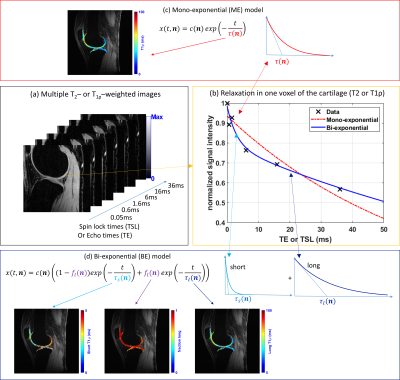 |
Computer Number: 98
4682. MR
Learned Pulse Sequence on Bi-Exponential 3D T2 and T1rho Mapping
of Healthy and Early Knee Osteoarthritis: Linear Discriminant
Analysis
M. Zibetti, H. De Moura, A. Monga, D. Singh, J. Samuels, R.
Regatte
NYU Langone Health, New York, United States
Impact: Learned pulse sequences are useful for early OA
detection, with T1ρ outperforming T2 mapping. Results
indicate that BE models can be advantageous if linear
discriminant analysis and the proper threshold are used.
|
|
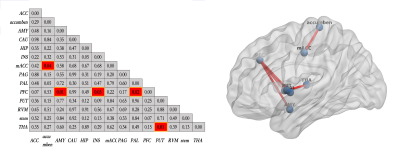 |
Computer Number: 99
4683. Assessing
the Central Analgesic Mechanisms of Tuina in Knee Osteoarthritis
Using Magnetic Resonance Imaging
Y. Zhang, K. Zhang, H. Wang, X. Zeng, L. Liu, G. Guo, H.
Wang
Fudan University, Shanghai, China
Impact: This study highlights tuina's analgesic effects
in KOA, potentially transforming pain management practices.
It raises new questions about integrating traditional
therapies into clinical settings, enhancing understanding of
pain mechanisms, and improving outcomes for patients with
chronic pain conditions.
|
|
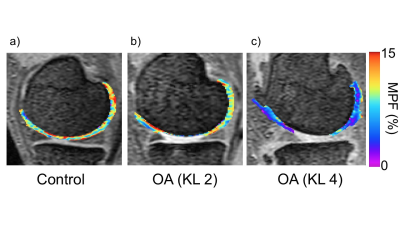 |
Computer Number: 100
4684. Evaluation
of Articular Cartilage in Knee Osteoarthritis Using
Macromolecular Proton Fraction Mapping
M. Ariki, Y. Fujiwara, M. Mio
Kumamoto University, Kumamoto, Japan
Impact: The findings of this study suggest that MPF
measurements may be useful for diagnosing OA, as they
reflect macromolecular degeneration in knee cartilage.
|
|
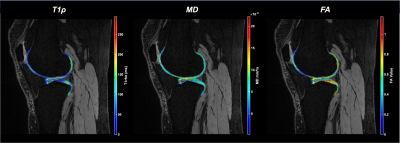 |
Computer Number: 101
4685. Assessing
the Repeatability of Quantitative MRI Biomarkers for
Osteoarthritis in Knee Cartilage
D. Martel, A. Adlung, G. Madelin, T. Kirsch, A. Ruiz
NYU Grossman School of Medicine, New York, United States
Impact: This study underscores the potential of T1rho
and MD as repeatable, non-invasive MRI biomarkers for
tracking knee cartilage health in OA patients. These
findings could guide earlier interventions, inform treatment
strategies, and enhance OA monitoring in clinical settings.
|
|
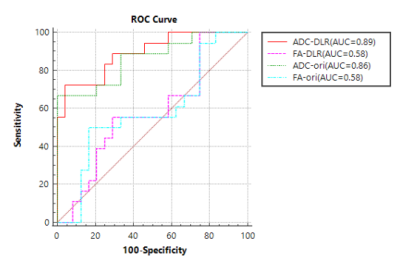 |
Computer Number: 102
4686. Knee
Osteoarthritis DTI using Deep Learning Reconstruction: A
Prospective Study on Quantitative Accuracy and Diagnostic
Efficacy
X. Wu, W. Liu, Y. Zha
Renmin Hospital of Wuhan University, Wuhan, China
Impact: The application of deep learning reconstruction
technology to select the appropriate acceleration factor can
significantly shorten the acquisition time of DTI sequence
images of the knee joint with good test-retest
repeatability.
|
|
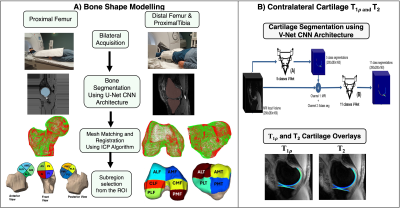 |
Computer Number: 103
4687. Association
between Knee and Hip Bone Shape Asymmetries and Contralateral
Knee Cartilage Health in Patients with Hip Osteoarthritis
R. Thahakoya, R. Bhattacharjee, M. Han, R. Souza, S.
Majumdar
University of California San Francisco, San Francisco, United States
Impact: The inter joint parameter relations helpful to
enhance our understanding of the interrelated nature of
joint health, particularly how bone shape asymmetries in the
hip and knee may contribute to the progression of Knee OA.
|
|
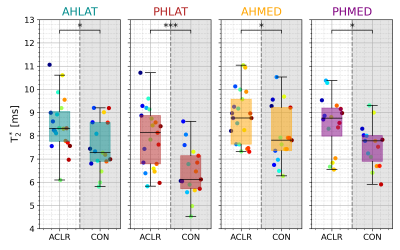 |
Computer Number: 104
4688. T1,
T1ρ and T2* mapping of menisci using UTE imaging in patients six
months after anterior cruciate ligament reconstruction
M. Krämer, H. Schulz, A. Nepal, N. Faber, S. Oehme, T. Jung,
G. Duda, F. Güttler, J. Reichenbach, N. Brisson
Jena University Hospital - Friedrich Schiller University Jena, Jena, Germany
Impact: UTE-based quantitative MRI enables objective
quantification of meniscal integrity – by comparing knees at
high risk of developing OA versus healthy knees. Our
approach may be used to detect patients with early meniscal
degenerative changes, precursing post-traumatic knee
osteoarthritis.
|
|
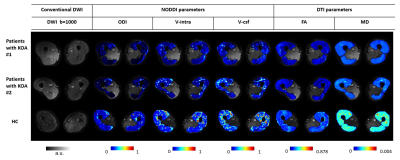 |
Computer Number: 105
4689. Age-related
microstructural changes in skeletal muscle by diffusion
microstructural imaging and its application in knee
osteoarthritis
Y. Wang, Y. Yang, R. Liao, J. Liu, X. Zhang, Y. Chen, D.
Han, Z. Zhang, X. Zhang, X. Zhang
Department of Medical Imaging, The Third Affiliated Hospital Southern Medical University, Guangzhou, China
Impact: NODDI effectively reveals microstructural
changes in thigh muscles during the early stages of KOA,
offering insights into alterations in myofibrils. This
technique quantifies nerve fiber density and orientation,
thereby providing additional information regarding muscle
changes in pathological conditions.
|
|
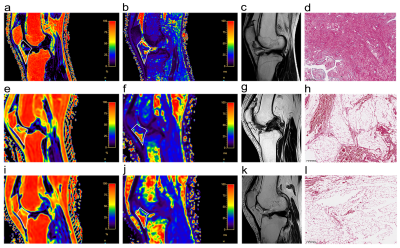 |
Computer Number: 106
4690. Quantification
of Infrapatellar fat pad fibrosis using MRI-derived PDFF: A
pathology-controlled study
B. Zhou, J. Wu, T. Zhao, Q. Yu, K. Jiang, X. Zhang, Q. Wei,
R. Zhang, H. F. Fang, H. Zhang, Y. Chen, X. Zhang, C. Huang
Department of Radiology,The Third Affiliated Hospital, Southern Medical, Guang zhou, China
Impact: PDFF and T2* measurements based on mDixon
technology provide a non-invasive and quantitative
assessment of IPFP fibrosis, especially PDFF.
|
|
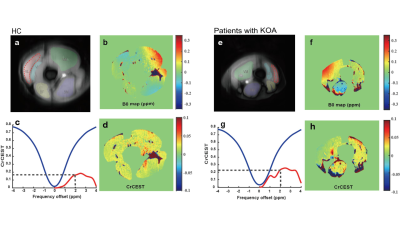 |
Computer Number: 107
4691. Quantification
of the Thigh Skeletal Muscle Creatine Content in Asymptomatic
Individuals and Patients with Knee Osteoarthritis
Y. Wang, T. Zhong, X. Zhang, Y. Chen, J. Chen, R. Liao, Y.
Chen, Z. Zhang, Y. Wu, X. Zhang
Department of Medical Imaging, The Third Affiliated Hospital Southern Medical University, Guangzhou, China
Impact: Thigh muscle creatine levels vary among people
and are affected by exercise intensity. Lower creatine
levels are linked to more muscle fat fraction, indicating a
possible link to fat metabolism and energy production, as
well as oxidative stress management.
|
|
 |
Computer Number: 108
4692. Diffusion
Tensor Imaging in Diseased Human Meniscus
N. Tod, S. Salem, R. Hu, S. Tabassam, J. Chen, Z. Liu, Y.
Xia, N. Wang
The University of Texas Southwestern Medical Center, Dallas, United States
Impact: DTI (diffusion tensor imaging) shows great
potential in detecting changes to the microstructure of
human menisci at various stages of degeneration. This
technique may allow for more precise pathological evaluation
and treatment selection for patients suffering from
degenerative joint disease.
|
|
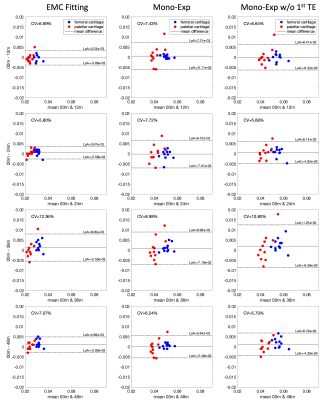 |
Computer Number: 109
4693. Early
Detection of Osteoarthritis in the Knee Using Echo Modulation
Curve-based T2 Mapping: Analysis in the Osteoarthritis
Initiative Dataset.

E. Marchetto, E. Montin, G. Koerzdoerfer, V. Mazzoli, O.
Cigdem, C. Deniz, N. Ben-Eliezer, R. Lattanzi
Bernard and Irene Schwartz Center for Biomedical Imaging, Department of Radiology, New York University Grossman School of Medicine, New York, United States
Impact: EMC T2 fitting
shows higher reproducibility and sensitivity in detecting
early OA in the knee cartilage compared to mono-exponential
models, suggesting that accurate T2 estimation
can help identifying cartilage changes before radiographic
evidence, potentially enabling earlier intervention
strategies.
|
|
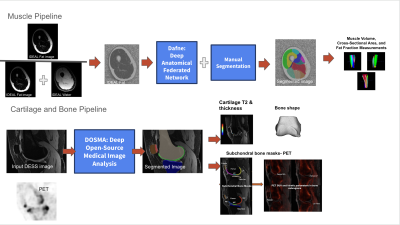 |
Computer Number: 110
4694. Exploratory
Investigation on Bone-Muscle-Cartilage Relationships in Knee
Osteoarthritis
F. Belibi, Y. Vainberg, G. Gold, F. Kogan, A. Goyal
Stanford University, Stanford, United States
Impact: More studies analyzing the muscle-bone-cartilage
relationships can further expand on this theory and help in
understanding the whole joint nature of OA.
|
|
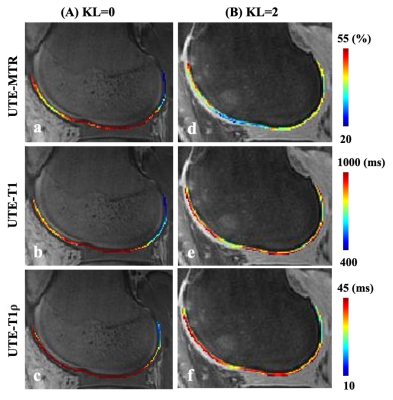 |
Computer Number: 111
4695. Quantitative
Ultrashort Echo Time MR Imaging of Osteochondral Junction in
Knee Osteoarthritis
D. Moazamian, M. Dastkareh, J. Athertya, S. Jerban, A.
Suprana, A. Lombardi, E. Chang, J. Du, Y. Ma
UCSD, San Diego, United States
Impact: UTE-MTR mapping of the osteochondral junction
offers a quantitative tool to assess cartilage degeneration
in osteoarthritis patients. This technique could improve
early diagnosis and provide insights into cartilage health,
potentially aiding in better management and monitoring of
osteoarthritis progression.
|
|
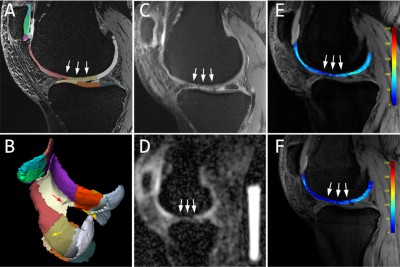 |
Computer Number: 112
4696. Patient
characterization at baseline using multiparametric MRI at 7T for
cartilage anabolic drug testing in osteoarthritis
D. Laurent, P. Szomolanyi, O. Zaric, V. Juras, E. Steijvers,
A. Meijs, N. Klarenbeek, K. Burggraaf, U. Schramm, J. Li, Y.
Gschwind, E. Raithel, F. Saxer, M. Schieker, S. Trattnig
Novartis Pharma AG, Department of Translational Medicine , Basel, Switzerland
Impact: The results of this study have implications for
clinical trials on cartilage drugs in OA, where new imaging
endpoints should be considered due to a small sample size
and short duration of treatment.
|
The International Society for Magnetic Resonance in Medicine is accredited by the Accreditation Council for Continuing Medical Education to provide continuing medical education for physicians.